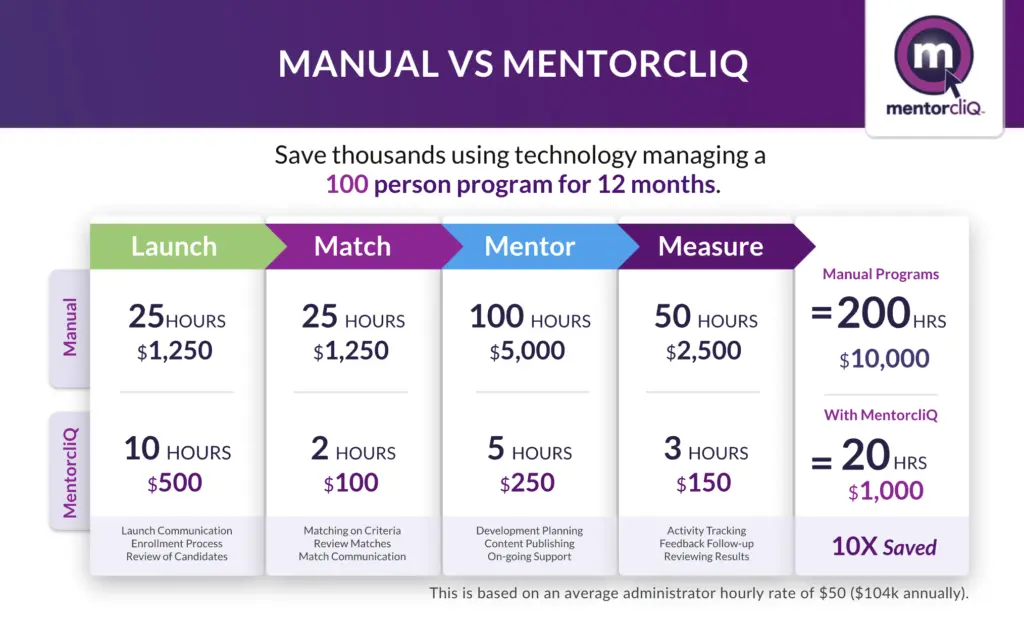Congratulations, you’ve been selected to create a mentorship program for your organization! But wait, where do you start? You can’t recall ever being in a mentoring relationship yourself, and for that matter, you’re not exactly sure what “mentoring” is. Is it coaching? Is it training? Is it counseling? All of the above, or none of these?
Take it with you:
Download your action guide on How to Start a Mentoring Program right here
Don’t worry, and don’t panic. We are here to help you. In this article, we will share helpful tips and best practices for how you can start mentoring in your organization. You can read this in full or jump to specific sections below.
START AT THE TOP: Need a more extensive explanation of mentoring? Try our complete guide to mentoring.
How Do I Start a Mentoring Program?
Do you find yourself asking those same questions? Then you’ve come to the right place. MentorcliQ has spent years helping enterprises design, launch, manage, and scale mentoring using our award-winning software. Read on for questions you should ask yourself on how to get started, factors you will have to consider, and examples of how this can work in the real world.

The amazing thing is that when you set yourself up for success, your employee mentorship program will:
- Boost employee retention rates (by up to 75% if using software)
- Increase employee engagement, employee satisfaction, and promotion rates
- Build a more inclusive culture fostering diversity and belonging
- Positively impact the professional lives of the people in your company
Consequently, if you’re trying to explore how to start a mentoring program for the first time, you’re going to need mentoring stats and other data like the above that prove the value and impact that such programs will have on your organization. That kind of information will be critical to getting executive buy-in for your program.
When you begin planning for your mentoring program, keep these foundational items in mind to help you get set up for success:
- Set the purpose. Why are you doing this?
- Set the population. Who is this for?
- Set the structure. What type of structure will fit your population?
When you’ve defined purpose, population, and structure, you’ve set the foundation for the remaining program launch action items. These elements will help you later design your communication plan along with a surveying plan so that you maintain momentum throughout the life of your program.
While these questions are the main drivers of planning your mentorship initiatives, one thing to consider is that there may be additional questions you should ask to get the bigger picture of mentoring in your organization. Below are eight additional questions you can ask:
8 Important Questions for How to Start a Mentoring Program
To start your mentoring program, begin by asking yourself these 8 questions:
- What is your overall vision and objective?
- Are there already mentorship programs that are up and running at your company?
- How are you currently using mentoring at your company? Which business problems or challenges does it address?
- How many people take part as mentees and mentors?
- Do you want to improve what already exists, expand what exists, or start from scratch?
- Who is in charge of initiatives that already exist (what department or group owns it)?
- Do you have the power, budget, resources, etc. to enact changes?
- Do you need to get the support of others to bring mentoring to your company or to change how you have been doing things?
Once you have answered these questions…
You can start to see the bigger picture for designing initiatives at your company. You may already have something in place that addresses the demands of high-potentials or that is part of a larger onboarding process.
Knowing where mentoring already operates and how it is being used will help you form a vision of what you want to accomplish with your plans. From there, you can begin the work of designing and planning and forming your plan to meet your needs.
For more advice on launching programs, be sure to bookmark the following pages:
- How Do I Run a Successful Mentoring Pilot?
- Modern Mentoring 2.0: The New Way to Run Mentoring Programs
- Leverage Virtual Mentoring to Engage Your Newly Virtual Workforce
- Mentoring Programs Formats
- Keys to Creating a Mentoring Culture
Defining Your Foundational Elements
If you decide you are ready to begin the mentoring process or improve upon the design of an existing initiative, you will need to use the three foundational elements to further structure your plan.
As stated above, you will have to examine why you are implementing a program, what outcomes you want to achieve, which employee associations or community you are targeting, or the audience you want to impact, what types of mentoring you want to use for your audience, and finally, what the timeline will be for launching your initiative.
Design Element #1: Purpose
From increasing employee engagement and addressing diversity and inclusion, to improving employee turnover rates and building a pipeline of leaders, your outcomes will take shape based on the unique needs of your company. To give you an idea of what outcomes you may want to focus on with your mentorship programs, answer the following questions:
- What is the result that you want to achieve through your mentorship program?
- What is its purpose to the organization?
- What problems could it solve?
- What business needs could it address?
- What are the tangible business results you want to achieve?
Pro Tip: When communicating the purpose, use language that will resonate with your specific audience. For example, you may want to avoid learning jargon, such as “learning objectives” and “succession planning,” if they don’t have meaning to your audience.
The more you clarify and describe the intention behind your mentorship programs using language that is meaningful to your audience, the easier the rest of the development process becomes.
Example #1: Using Women’s Leadership Mentoring, here is a good example of a purpose statement:
“Women’s Leaders Mentoring aims to create a pipeline of female leaders by providing women with tools and opportunities to accelerate their careers through career planning, enriched work experience, and visibility opportunities with leadership.”
Example #2: Using Women’s Leaders Mentoring, here is a bad example of a purpose statement:
“Women’s Leaders Mentoring aims to meet learning objectives set for engaging female talent within the organization.”
Unlike the first example of a purpose statement, the second example is too vague about the goals and uses jargon and a broad statement to capture a goal that should be specific and results-oriented. Ultimately, it tells us nothing other than that your target group is women.
Design Element #2: Population
The second design element you must consider is who you want your target employee population to be. The way you configure and set up your eligibility criteria can change depending on who your mentees and mentors will be, so it is critical that you have a central audience in mind when you formulate your plans. This will help guide some subsequent decisions you have to make. To help you identify your core audience, answer the following questions:
- What audience are you trying to impact (e.g., high-potentials, new hires, new managers, women’s initiatives)?
- Who will be the mentee?
- Who will be the mentor?
- Will these groups be static, or can their roles change as the mentoring program progresses (i.e., can mentees become mentors)?
- Will people be required or invited to join?
- Can they choose to join your mentorship program or opt-out?
- How will you recruit new mentees and mentors?
- How will you encourage non-participants to join in future cycles?
Pro Tip: While it is good to be specific about the groups you want to target, try not to get too restrictive. This can significantly limit your mentor pool, which sets a lower limit on the number of mentoring matches you can make.
Example #1: Using a Global Open Program, here is a good example of a targeted population:
- Mentors: Full-time employees who have been with the company for at least a year and who are at a program manager level or above.
- Mentees: Full-time employees who have been with the company for at least 3 months
Example #2: Using a Global Open Program, here is a poor example of a targeted population:
- Mentors: Full-time employees who have been with the company for at least 5 years, have gone through the program managers skills experience course, and whose job title is Vice President or above.
- Mentees: Full-time employees
Unlike the first example, the mentor pool in the second example created barriers by being too specific and will likely not produce enough mentors to support a global open format. This population would work for a smaller leadership development program where you need to be targeted in your population but is too restrictive for an open format.
Design Element #3: Program Structure
The third element you should focus on as you design your mentorship program is deciding what the structure will look like. By having determined the purpose and population in the previous steps, you can now design the right type of program that will address your needs. To help you figure out what you want your mentoring program to look like, answer the following questions:
- Will you use pairs or groups?
- Do you want administrators to make the matches, or will mentees and mentors be able to find their own partners?
- Can anyone join, or will it be restricted in some fashion?
- How long will relationships last?
- What focus areas and competencies should mentees and mentors be choosing from to help with making matches?
- What milestones should people accomplish to help them know they are making progress in their relationships?
MentorcliQ’s software (and the experts who support it) will help guide you through these questions and more so that you design a program that fits your audience and purpose—and that produces the desired results. You can have confidence that you are launching a well-crafted and thoughtful initiative by figuring out your mentoring process, how you want to match mentors and mentees, support participants during the process, communicate with them throughout their relationships, and conduct surveys to gauge their satisfaction.
Pro Tip: Survey your mentees and mentors at various points throughout their relationships in your cycle. Make sure to capture data around the relationship including how much time people are investing in their mentoring sessions and what they are focusing on. It’s also recommended that you send out periodic satisfaction surveys to measure how everyone feels about their mentors or mentee match and the overall mentoring experience.
Writing survey questions can be an art form. Try to avoid compound questions; long or confusing questions; or descriptions that are full of jargon. A best practice is to keep your questions short, simple, and direct.
Example #1: One good survey question might ask:
- Did your mentor provide you with advice that helped you do your job?
Example #2: A poorly written survey question might ask:
- Did your mentor live up to your expectations by helping you learn skills and perform on the job so that you could eventually get a promotion and stay with the company?
Unlike the first example, the survey question in the second example is long, confusing, and trying to ask too many things winning one question. Be clear in the questions you ask your participants, and try to only ask the questions that you really need to.
Real-World Examples of Successful Mentoring Programs
Now that you are familiar with the three elements that you must consider as you design your mentoring program, let’s examine what these factors look like in real-world mentoring program designs that our clients have created. Here are three examples of mentoring programs we helped our clients craft and launch.

Lifelong Career Development at KeyBank: KeyBank is a regional bank with a strong culture of career development. Their program is geared towards retention and helping their people develop their life-long careers at KeyBank. This comes through strongly in their design as they encourage their people to “bring your own aspirations”.
As an organisation-wide initiative, participants can self match, and both parties specifies what kind of relationship they are looking for. These design points along with many others help KeyBank meet their goals.
The biggest and most exciting result is the bottom line impact on the organization. Their return on investment (ROI) is measured in millions of dollars by increasing retention by 76%. Read more of KeyBank’s story.


Strong Inclusive Cultures at Cardinal Health: Mentoring has always been part of the strong inclusive culture at Cardinal Health. As a key element to its global talent management strategy, Cardinal Health has championed mentoring to offer individualized learning experiences to their people to help them grow personally and professionally.
In 4 short years Cardinal Health expanded their reach to over 20 mentorship programs across the United States, Canada, Mexico, Caribbean, and Asia Pacific regions, spanning topics in career development, functional expertise, and diversity and inclusion.
The benefits this had at Cardinal Health speaks for itself. With incredibly high employee experience scores, 97% satisfaction across the mentoring population, Cardinal Health was able to save over $5 million through employee retention with their initiative. Read more of their story.

Award Winning Diversity & Inclusion with Nielsen: Nielsen’s Global MyMentor makes mentoring available across Nielsen’s entire workforce and in support of their broader diversity and inclusion goals to ensure every associate has access to professional development opportunities. In their first 9 days they enrolled over 2,500 people across of each of the 80+ countries in which they operate.
Within 8 weeks this number expanded to include over 15% of their workforce with their associates being engaged in mentoring with over 16,800 hours being invested in the initiative by their associates. In 2020, Nielsen won a Brandon Hall award for Best Diversity & Inclusion Strategy supported by their Global MyMentor program. Watch more of their story.

Pro-Tip: Other things outside of the three design elements to consider for your mentoring program…In addition to determining the purpose, population and structure, you should also consider other factors that will impact your program design, implementation, and outcomes. These include:
- Identifying and engaging stakeholders
- Implementing training for your participants
- Assessing and mitigating risks related to your program
Create a Mentoring Program in 10 Steps
Now that you have set your three design elements, you are ready to build your mentoring program. We recommend the following ten actions you can take for starting a mentoring program and ensuring success in your organization.
- Understand what mentoring is and isn’t
- Align mentoring with your organization’s objectives
- Socialize your concept and gauge buy-in
- Request and integrate feedback
- Create structure for delivery
- Recruit participants and train them
- Match participants
- Guide participants to success
- Continuously measure, monitor, and modify
- Consider software for support
1. Understand what mentoring is and isn’t
Starting off, you can tell your Learning & Development team members not to worry, as mentoring isn’t a replacement for training. Mentoring differs from more traditional instruction initiatives in that the objectives for development are individual and driven by the mentee. Training is usually a set curriculum covering lessons or skills required for a broader population.
Mentoring is a more interpersonal, informal vehicle for professional development. It doesn’t rely on lesson plans and evaluative assessment. It’s more one-to-one, up close and personal (or virtual, as the case may be). Lastly, it is a personal investment, for both mentors and mentees, and with investment, comes the expectation of benefit. The Association of Talent Development defines mentoring as:
“Mentoring is a reciprocal and collaborative at-will relationship with the purpose of the mentee’s growth, learning, and career development. Often the mentors and mentees are internal to an organization, and there is an emphasis on organizational goals, culture, and advice on professional development.
Mentors often act as role models for their mentee and provide guidance to help them reach their career goals. Mentoring can be formal or informal. In an informal environment, mentees set goals, but they are usually not measurable and the relationships are unstructured.
For a formal relationship, there are actionable and measurable goals defined and set with determined requirements.”
2. Align mentoring with your organization’s objectives
People invest time and energy into things that have impact, things that move the right needles. Spend some time identifying which metrics, goals, and strategic objectives will be positively affected. No matter the positive intent of any initiative, if it doesn’t fulfill stated or identified needs of your workforce or of the company, support will be hard to come by.
Your target population will have to see the benefits they can realize through their involvement. Similarly, stakeholders and partners will need to believe the results will be worth their investment.
One way to do this, is by asking questions along the way. Start with: “What’s in it for my stakeholders?”
Check out this article featured in HR.com which explains mentoring ROI and the results from MentorcliQ customer Clorox.
3. Socialize your mentoring concept and gauge buy-in
Before announcing your intent to introduce mentoring, you’ll want to get a pulse from those you hope will benefit. Depending on your company’s size, you may want to start out with some roundtable discussions with your relevant stakeholders. What needs do they express? What solutions do they propose? Is it a viable, and desirable, option?
If so, enthusiasm and support from these front line conversations will identify potential champions for implementation and pave the way to your next discussions with stakeholders.
4. Request and integrate feedback
When you’re ready, set time with appropriate partners and stakeholders to share what you’ve learned and your initial thoughts for execution.
Why did we emphasize initial thoughts? At its heart, mentoring is a collaborative process, and creation of a program should be as well. Sponsors, stakeholders, and support resources will all have a vested interest in making the program a success. They’re likely to have some ideas of their own.
Leaving room to hear, discuss, and validate this feedback provides two key benefits:
- You are likely to be presented with perspectives, obstacles, and solutions you may not have considered.
- You’ll have the respect and support you need when the time comes to launch your program.
5. Create structure for delivery
With objectives set, buy-in from stakeholders secured, and support from leaders guaranteed, you’ve got the green light to proceed! Now, how is it all going to work? Through your discussions thus far, (hopefully) you’ve got answers to the following:
- Who is the target population?
- What are the requirements for mentors?
- What are the requirements for mentees?
- How will participants be recruited (open invitation, private invitation)?
- What criteria will be used to pair mentors and mentees?
- What sorts of resources, guidance, and/or coaching will be provided?
- What is the intended duration of mentorship?
- How will communications be handled?
- When will the program launch and how will this be executed?
- How will progress be measured?
- Who will oversee the program?
- How will your participants meet? In-person? Virtually?
- Once you’ve outlined the above, you’re ready to kick-off!
6. Recruit participants AND TRAIN THEM
There are many ways to recruit participants for your mentoring program. You’ll probably want to begin with the recruitment of mentors. This gives you an idea of overall capacity; obviously, you can’t invite 1,000 mentees if you only have 10 mentors. Or, you could allow participants to self-select their role (mentor, mentee, or even both). Most companies don’t do this out of the gate, preferring to start with a more defined list of mentors and mentees, and facilitating the first few matching cycles.
Whichever method you choose, it’s a good practice to:
- Give advance notice of enrollment start and end dates, and then remind people once (maybe twice).
- Provide a long enough window for enrollment. Everyone gets lots of emails. Allow for messages getting buried, lost, or even ignored. Understand that even the best-intentioned individuals may procrastinate.
- Stick to your timelines, which means you should open and close enrollment as announced. This is a fine art, as you don’t want to be too strict and potentially exclude participants, but too much leniency can undermine any sense of urgency and importance.
- Train your mentors! Read more below.
MENTOR TRAINING = MENTOR READINESS & CONFIDENCE
In order to be effective mentors, even the best and most seasoned participants need mentor training and guidance so they are ready to empower others. Companies sometimes hesitate to start internal mentoring because they do not think they have enough employees OR they fear that employees are not ready to be mentors.
With mentor coaching, companies can ensure that mentors are ready, confident, and motivated to empower employee development. MentorcliQ’s MentorLab is designed and facilitated by Jenn Labin, author of Mentoring Programs That Work and ATD Master Trainer. With a 98% satisfaction rating mentors viewed the course as providing:
“Useful and practical tools with applicable advice that touches on all the right themes on how to have the best possible relationship so they can easily apply what I learned to my mentorship so that I am effective with my mentee.”
7. Match participants
And now, the fun part: matching mentors and mentees! This is the step where you’ll be creating relationships that will change people’s careers and lives. That’s the good news.
What’s the “bad” news? Working through matches can be a time-intensive, laborious effort. To effectively review participant profiles, consider their preferences, and create compatible pairings takes keen knowledge of the populace, solid understanding of interpersonal dynamics, and a heaping helping of organizational savvy. In other words, it can be like herding cats … hundreds and thousands of cats. But we didn’t come this far to give up now!
If you’re reading this, you’ve also been reading about automation options and platforms to facilitate mentoring initiatives. With the right technology and expertise, creating engaging, impactful relationships can be as easy as clicking your mouse. (You can even think of mentoring software as the laser pointer that is going to corral all of those cats.)
When should you consider software? The general rule of thumb is: if you’re matching more than 75 people, you’ll want to use automation. If you don’t, you’ll have to consider a total number of match scenarios that is approximately equal to NI/2 …let’s just say there’s a bit of math involved (the kind you won’t have to do if you automate). Whichever method you use to create your pairs (administrator matching or self-matching), once they’re made, introduce mentors to mentees and let mentoring begin!
8. Guide participants to success
A little bit of structure goes a long way. Create a few checkpoints throughout the program and provide the right resources to help mentors and mentees through them. Create a communication calendar that maps out which program communications you plan on sending each month of the relationship. For example, a simple 6-month program communication schedule might look like this:
| Month 1Program announcements and invitationsEmail Blast that matches have been madeGetting started guide for participants | Month 2Tips on being a great menteeTips on being a great mentor | Month 3Relationship check-in conversationSatisfaction survey |
| Month 4Goal check-inProgram update | Month 5Tips for finishing the relationship | Month 6Program closure surveyThank you for participating emailNext actions for future cycles |
9. Continuously measure, monitor, and improve
Okay, so the program is announced, pairs are matched, and things are underway. Time to relax? Not quite. Throughout the course of the cycle, you’re going to want to:
- Check in with participants to gauge relationship satisfaction
- Gain understanding of time being spent in development-related activities
- Identify trends in focus areas and topics discussed
- Gather feedback around program communication and structure
Keep your finger on the program’s pulse to identify areas of efficacy and success, as well as areas for improvement. This will ensure that each iteration of your program improves. Keep what works and re-think what doesn’t.
10. Consider mentoring software for support
Depending on the size and scope of your mentoring program, it may be reasonable to evaluate using a mentoring software for support. There is a significant amount of effort that goes into designing and launching your program, matching participants, supporting the mentor mentee relationship, and collecting data for reporting. For smaller programs, it may make sense to use spreadsheets and other internal tools to support and manage all aspects of the mentoring program. While the benefits to software are endless, once you start to scale your program, software will have the following early wins:
- Reducing the administrative costs of your program and increasing ROI
- Making better matches between participants leading to higher satisfaction scores
- Streamlining data collection to create robust metric reporting
How much time is actually saved by implementing MentorcliQ software?

Ultimately, the best mentoring programs are designed to be scalable so that the results increase over time and the management efficiency (# of hours needed) of the mentoring program decreases. Larger initiatives that do not utilize software may cause lower engagement with the program participants, inaccurate employee engagement data for the leadership team, and ultimately, low participant numbers and overall dissatisfaction with the program.
Having the ability to manage mentoring programs with high participation rates, engaged partners, along with positive outcomes and accurate employee engagement numbers, takes the work of a mentoring software solution like MentorcliQ!
And there you have it … the 10 fundamental steps for implementing mentoring in your organization. With a little research, collaboration, planning, and stewardship, you’re going to have a successful program and make significant impacts to your people and your organization.
You’ve taken the first step to starting a mentoring program. Now keep going!
We Can Help! All great ideas start somewhere… Regardless of where you start the process, the fact that you want to implement mentoring is a positive goal. We have helped hundreds of organizations design, launch, run, and manage mentoring programs over the years, and we’d love to help you too. Contact us to discuss your ideas, vision, and goals. Our experts are here to help. Because at MentorcliQ, we believe you can do more with mentoring.




